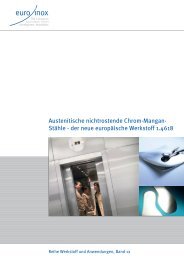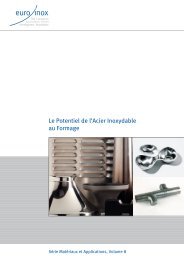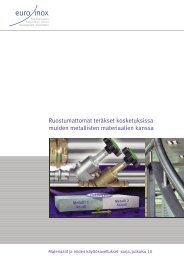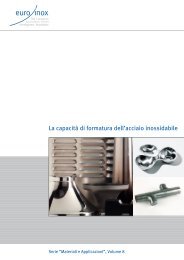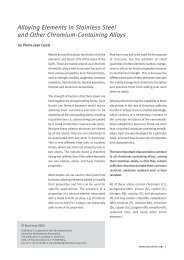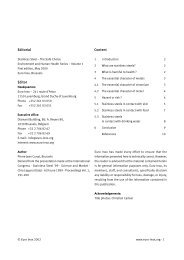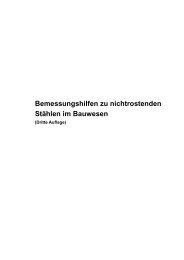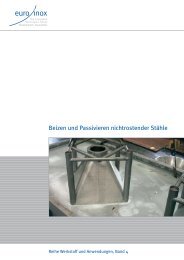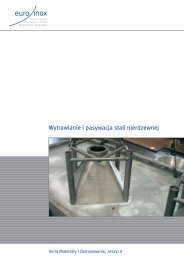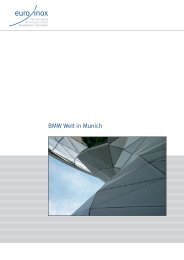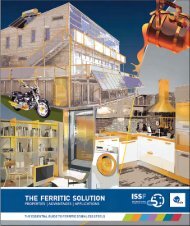Innovative Stainless Steel Applications in transport ... - Euro Inox
Innovative Stainless Steel Applications in transport ... - Euro Inox
Innovative Stainless Steel Applications in transport ... - Euro Inox
Create successful ePaper yourself
Turn your PDF publications into a flip-book with our unique Google optimized e-Paper software.
Table 31. Tensile strength test results for arc-brazed and laser-brazed butt jo<strong>in</strong>ts <strong>in</strong> various<br />
austenitic grades (DOLTRAC).<br />
Weld<strong>in</strong>g Filler metal Tensile strength (N/mm 2 )<br />
304SP 1.4318<br />
2B C850 C1000<br />
BM - 682 956 1008<br />
arc braz<strong>in</strong>g CuSi3 721 897<br />
arc braz<strong>in</strong>g CuAl5Ni2 710 783<br />
laser braz<strong>in</strong>g CuAl5Ni2 710 783<br />
arc braz<strong>in</strong>g CuNi10Fe 714 801<br />
laser braz<strong>in</strong>g CuNi10Fe 714 778<br />
The results <strong>in</strong>dicate that for 304SP, nom<strong>in</strong>al tensile strength values higher than the base<br />
material can be reached. This is probably due to the test arrangements and sample<br />
geometry, etc. but it is still a very promis<strong>in</strong>g result. It is also worthy of note that the<br />
measured strength values rema<strong>in</strong> more or less constant regardless of the filler metal or<br />
heat source used. Furthermore, the values are always higher than those for laser or<br />
MAG weld<strong>in</strong>g – but this may also be due to differences <strong>in</strong> experiment arrangements,<br />
s<strong>in</strong>ce the results orig<strong>in</strong>ate from different projects.<br />
For the high-strength cold-rolled 1.4318 material, the brazed samples show about<br />
10 - 20 % lower tensile strength values than the base material, as might be expected.<br />
Also, here, the differences between braz<strong>in</strong>g methods or filler materials are negligible.<br />
Unfortunately, no results directly comparable to arc-welded or laser-welded jo<strong>in</strong>ts were<br />
available for this material.<br />
5.1.2 Fatigue and corrosion fatigue strength<br />
Comparable fatigue and corrosion-fatigue data is available from a recent F<strong>in</strong>nish<br />
national project (Huhtala 2008). These tests were carried out us<strong>in</strong>g transverse test<br />
coupons of 3 mm austenitic sta<strong>in</strong>less sheets, <strong>in</strong> various grades. The coupons were<br />
designed to fulfil the requirements of ASTM E 466-96, especially with regard to<br />
curvature radius. The jo<strong>in</strong>ts were welded from one side, us<strong>in</strong>g match<strong>in</strong>g flux-cored<br />
308L-type filler metal for 1.4301 and 1.4318 grades. Exceptions were obviously the<br />
reference experiments made us<strong>in</strong>g CuSi3 solid-wire arc-braz<strong>in</strong>g filler metal.<br />
Furthermore, some post-weld mechanical treatments were tested us<strong>in</strong>g ultrasonic<br />
peen<strong>in</strong>g and grit blast<strong>in</strong>g.<br />
The International Institute of Weld<strong>in</strong>g (IIW) Commission XIII “Fatigue of welded<br />
components and structures” (a globally recognised authority <strong>in</strong> fatigue assessment and<br />
design of welded structures) commonly uses the term FAT to describe the fatigue<br />
94



